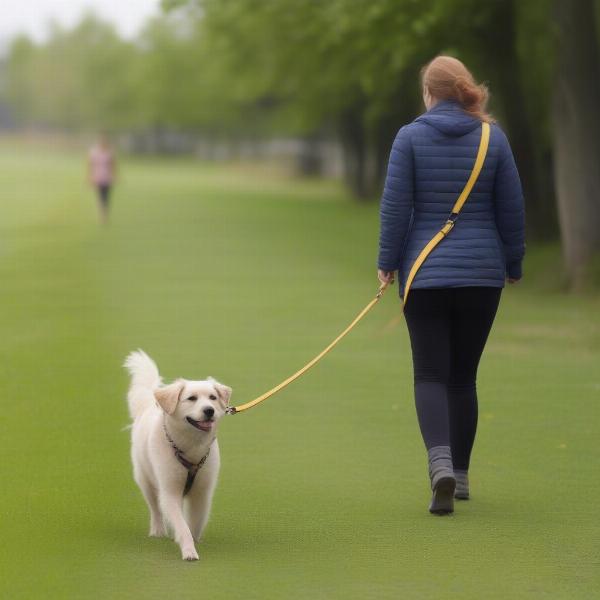TTA, or Tibial Tuberosity Advancement, is a surgical procedure performed on dogs to stabilize the knee joint, specifically addressing cranial cruciate ligament (CCL) ruptures. While not a breed itself, “TTA dog” refers to a canine that has undergone this specific surgery. Understanding the needs of a TTA dog is crucial for their successful recovery and long-term well-being. This involves specialized post-operative care, a tailored exercise regimen, and careful monitoring. Let’s delve into the world of TTA dogs and explore how to provide the best possible care for them.
A CCL rupture is a common injury in dogs, similar to an ACL tear in humans. The CCL is a vital ligament in the knee joint that provides stability. When ruptured, it causes pain, lameness, and instability. TTA surgery offers a dynamic solution to this problem by altering the biomechanics of the knee joint. It involves advancing the tibial tuberosity, the bony prominence where the patellar tendon inserts, changing the forces acting on the CCL and stabilizing the joint. This allows dogs to regain mobility and enjoy a pain-free life.
Post-Operative Care for TTA Dogs
After TTA surgery, your dog will require specific care to ensure proper healing. Strict rest is crucial in the initial weeks, limiting movement to short leash walks for bathroom breaks. Pain management is paramount, and your veterinarian will prescribe appropriate medications. Regular check-ups are essential to monitor the healing process and address any potential complications.
Physical therapy plays a significant role in the recovery process. Your vet may recommend specific exercises to improve range of motion and muscle strength. Hydrotherapy, or water therapy, can be particularly beneficial as it provides low-impact exercise.
Managing Exercise and Activity for TTA Dogs
A carefully planned exercise program is crucial for TTA dogs. Initially, activity should be restricted to short, controlled leash walks. As the healing progresses, the duration and intensity of exercise can be gradually increased. Activities such as running, jumping, and playing fetch should be avoided until cleared by your veterinarian.
 TTA Dog Exercise
TTA Dog Exercise
Hydrotherapy can be an excellent form of exercise during recovery, providing a supportive environment for strengthening muscles without putting excessive strain on the healing joint. Always consult with your vet before introducing any new exercise to your TTA dog’s routine.
Long-Term Management and Considerations for a TTA Dog
While TTA surgery is generally successful, long-term management is essential for optimal outcomes. Maintaining a healthy weight is crucial to minimize stress on the knee joint. Regular, moderate exercise is important to keep the muscles strong and support the joint.
Continuing physical therapy exercises, as recommended by your veterinarian, can help maintain joint health and flexibility. Regular check-ups with your vet are essential to monitor the long-term health of the knee and address any potential issues early on.
Conclusion
Caring for a TTA dog requires dedication and understanding. By following the post-operative care instructions, managing exercise appropriately, and focusing on long-term health, you can help your dog regain mobility and enjoy a happy, pain-free life. TTA surgery offers a successful solution for CCL ruptures, allowing dogs to return to their active lifestyles.
FAQ
- How long is the recovery period for TTA surgery? Recovery typically takes several months, with strict rest required in the initial weeks followed by a gradual increase in activity.
- What are the signs of complications after TTA surgery? Increased pain, swelling, redness, or discharge from the incision site should be reported to your veterinarian immediately.
- Can my dog return to normal activity after TTA surgery? Many dogs can return to near-normal activity, but high-impact activities may need to be modified or avoided.
- What is the success rate of TTA surgery? TTA surgery has a high success rate, with most dogs regaining good mobility and function.
- Is TTA surgery expensive? The cost of TTA surgery varies depending on the veterinarian and location but is generally considered a significant investment.
- Are there any alternatives to TTA surgery? Other surgical options for CCL ruptures include TPLO and extracapsular repair. Your veterinarian can help determine the best option for your dog.
- What type of physical therapy is recommended after TTA surgery? Physical therapy may include range of motion exercises, strengthening exercises, and hydrotherapy.
ILM Dog is your trusted source for comprehensive information on dog breeds, health, training, nutrition, and more. We offer expert advice to support dog owners worldwide in providing the best possible care for their furry companions. Whether you are a seasoned dog owner or just starting your journey, we are here to help you navigate the world of dog ownership. From hurtta dog coats to dog harness hurtta, we cover a wide range of topics to help you make informed decisions. Contact us at [email protected] or +44 20-3965-8624 for personalized guidance. ILM Dog is committed to helping you and your dog live a happy and healthy life together.